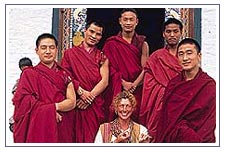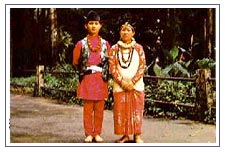The Inhabitants And The Migrants

The
Hindu epics and Puranas refer to the original inhabitants of the Himalayas-
the Kulinds, Kiratas and Kilinds, Kiratas and Kinnars and later texts
mention the Khasas and the Darads. Today three ethnic types constitute the
Himalayan population: Negroids, Mongoloids and Aryans.
From very early times there have been migrations into the Himalayas and
within it. Spiritual quest motivated a few to migrate there, and a small
minority responded to the call of these mountains to test their own
endurance and will power. Pursuit of profit propelled others. Reasons of
state dictated the posting of garrisons even in remote, desolate areas. All
these factors combined over a period of time to change significantly the
complexion of the local populace. There have been waves of migration from
Nepal to Sikkim and Kumaon, for instance, and from Tibet. At present it is
extremely difficult to separate the different racial strains.
The Bhutanese are Bhutiyas of Mongolian origin who
refer to themselves as Drukpa-inhabitants of Druk Yul or the 'Land of the
Thunder Dragon'. Apart from a few obscure areas of Nepal and Ladakh, and
Spiti in India, the Bhutanese are the only large group to follow traditional
Buddhism and, despite the building of roads and controlled introduction of
tourism, have maintained many aspects of the culture.

The
Sikkimese consist of three different groups - the Lepchas, the Bhutiyas and
the Nepalis. The Lepchas are the original inhabitants but are now in a
minority. Not much is known of their history before their conversion to
Buddhism and the enthronement of Phuntsok Namgyal as the first historic
ruler of Sikkim.
The people of Nepal are a complex mix of racial
patterns. The dominant Hindu castes of Brahmin, Thakur and Chetri, along
with several others speak Nepali. The Gurungs, Magars, Tamaings, Rais and
Limbus form the Gurkha regiments of the British and Indian armies. These are
part of the mongoloid, tribally organized groups of hill farmers who
dominate the middle hills. The Sherpas of the Solo Khumbu region in the
northeast of the country are amoung the many Bhutiya groups who speak
dialects of Tibetan.
People Of Himachal Pradesh
In Kumaon and Garhwal, in the central
Himalayas, Khasas and Doms were the original inhabitants. The Khasas,
historians surmise, were a west Central Asian nomadic tribe who entered
through the northwest and spread from Kashmir to Assam.
In Himachal Pradesh, the descendants of these
Khasas are known as "Kanets" and now claim Rajput status. The
majority of the population in the present-day central Himalayas has Khasa
ancestry. Immigrant Brahmins and Kshatriyas from the plains brought caste
division with them and introduced new forms of social organization rooted in
Hindu orthodoxy.
The Ladakhis are of ethnic stock different from that of
the people of Kumaon and Garhwal. According to folklore, Ladakh was once
totally populated by Darads. The latest archaeological finds give credence
to this popular belief. The Mons belonging to the Mongoloid stock, and who
are now far more numerous there, seem to have migrated at a much later date.
Most people in the Himalayas sustain themselves by a combination of
agriculture and animal husbandry. Until very recently, those inhabiting the
higher reaches migrated to lower altitudes during the winter months. Trade
played an important role in the lives of the frontier villages in Ladakh,
Himachal, Kumaon and Garhwal. Before the advent of the British, the contacts
of Sikkim and Bhutan with Tibet were closer and more frequent.






 The
Hindu epics and Puranas refer to the original inhabitants of the Himalayas-
the Kulinds, Kiratas and Kilinds, Kiratas and Kinnars and later texts
mention the Khasas and the Darads. Today three ethnic types constitute the
Himalayan population: Negroids, Mongoloids and Aryans.
The
Hindu epics and Puranas refer to the original inhabitants of the Himalayas-
the Kulinds, Kiratas and Kilinds, Kiratas and Kinnars and later texts
mention the Khasas and the Darads. Today three ethnic types constitute the
Himalayan population: Negroids, Mongoloids and Aryans.  The
Sikkimese consist of three different groups - the Lepchas, the Bhutiyas and
the Nepalis. The Lepchas are the original inhabitants but are now in a
minority. Not much is known of their history before their conversion to
Buddhism and the enthronement of Phuntsok Namgyal as the first historic
ruler of Sikkim.
The
Sikkimese consist of three different groups - the Lepchas, the Bhutiyas and
the Nepalis. The Lepchas are the original inhabitants but are now in a
minority. Not much is known of their history before their conversion to
Buddhism and the enthronement of Phuntsok Namgyal as the first historic
ruler of Sikkim.